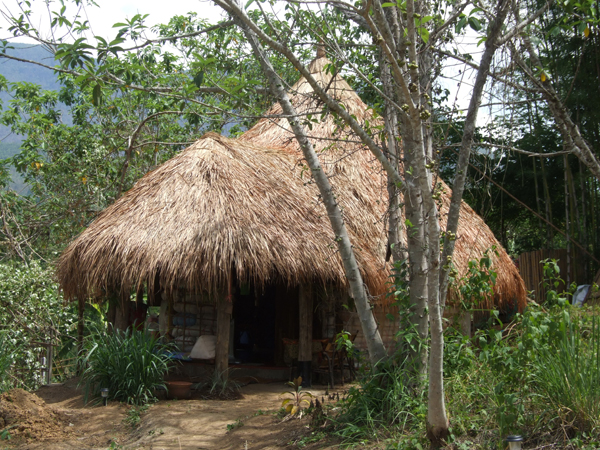
“Slightly before my 60th birthday I realised I had made no plans for my old age, and did not have any money put aside for it either. Thailand was my home, but no government pensions available, so what could I do that I would enjoy, which would also bring in a bit of money to live by. I decided to buy some land with my last few pennies, and go to the UK for a few years and earn some money, and save every penny I could. I bought a fantastic piece of land in Chiang Dao, northern Thailand, and spent several years in the UK saving like mad.
While in the UK I focused on what to do with the land, and decided a small B&B would be perfect. But I would not be able to afford a conventional building – unless I wanted to stay in the UK for at least a decade – so I began to think about building with natural materials. I went on several workshops and I was sold! If I won the lottery tomorrow I would still be building with natural materials!
I left the UK November 2012 and have been in Chiang Dao ever since, and I am building the most amazing domes with colourful local workers and wonderful volunteers. This Blog tells the story of how we built the Chiang Dao Roundhouses B&B.
Update: I am in my new home! Me and Toni and the kittens moved in a couple of days ago and we all love it! At the moment we are squashed into one roundhouse, but the second is now underway and hopefully it will only be a week or so before that will be ready for habitation, and we can spread out a bit.”
Read all the details and see lots of photos at Maggimck Blog

I’m late commenting but, just wish to say “Congrats on the build” Hope your last half is 100 times better than the first half! Live well and long.
As I get older I really appreciate faster, easier building methods. Rice hull construction falls in that category and can be an excellent way of building as long as you take certain precautions. Rice hulls will rot fairly quickly in hot, humid climates and so great care needs to be taken to prevent water damage. I would add a waterproof drape (6 mil plastic sheeting) along the top of the wall in case of roof leaks. Maintain the roof well so it never leaks. Build wide roof overhangs. Build a rainscreen to protect the walls if necessary. I would not build domes this way. Almost certainly domes will leak at some point and the rice hulls will rot.
Considering adding a burlapcrete rainscreen over the entire structure.
http://annesley.wordpress.com/burlap-crete-explained/
Rainscreens http://en.wikipedia.org/wiki/Rainscreen
As I get older, I really appreciate faster, easier lots of things… but that’s another story.
I also appreciate some slower things too… but I won’t go into that either.
heh heh
I read her entire blog. It’s a fun read. Anyone who has the time, I encourage them to go to the beginning of Maggimck’s blog and read it straight through.
Constructing two domes and two round(ish) houses, and a porch, and an outdoor shower, and some roofed connecting pathways is a very impressive accomplishment. She got all that done in 6 months!! She had plenty of help, but there’s nothing wrong with that. It doesn’t detract from what she’s built, and the speed in which she has built it.
I’m betting that the homemade Ice Cream vendor that stopped by on the hot days was perhaps the most important guy in the whole operation.
Other than the dog. ;)